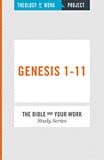Seeing the Good Side of Work: Creativity at Work (Genesis 2 Sermon Notes)
Newsletter / Produced by The High Calling
Genesis 2:19-20a
Now the LORD God had formed out of the ground all the wild animals and all the birds in the sky. He brought them to the man to see what he would name them; and whatever the man called each living creature, that was its name. So the man gave names to all the livestock, the birds in the sky and the wild animals.
Theological Point: We have been created by a God who calls us to engage the world creatively.
Introduction: Work can be exhausting. This is especially true when we feel like every day, we are doing the same things over and over again. We feel like we are merely cogs in a big machine that could exist with or without us. We don’t recognize our own value because it seems like anyone with a pulse could do what we do.
Work should be better than that. In the last sermon, we talked about how work is good. In this sermon, we are exploring the reason that work can truly be enjoyable: work can be exciting when it involves creativity. In the second chapter of Genesis, we have witnessed God’s epic creation unfold. We are told that a man named Adam was placed in a garden that God had already described as “good.” In Genesis 2:19-20, Adam is given an interesting job: “Now the LORD God had formed out of the ground all the wild animals and all the birds in the sky. He brought them to the man to see what he would name them; and whatever the man called each living creature, that was its name. So the man gave names to all the livestock, the birds in the sky and the wild animals” (Gen. 2:19-20a). In the midst of a creation that God had already declared as good, the man is given the job of continuing the work in an interactive and creative way. He was tasked with naming the animals. This was no menial task. This called for active use
of his brainpower and inventiveness.
I would argue that creativity continues to be a quality that God honors. In the book of Exodus, as God is giving his instructions for the building of the tabernacle, we are told about two specific workers who will not only be worker drones responsible for carrying tools and materials, but who will be instrumental in using their specific gifts to make a creative contribution:
Then Moses said to the Israelites, ‘See, the LORD has chosen Bezalel son of Uri, the son of Hur, of the tribe of Judah, and he has filled him with the Spirit of God, with wisdom, with understanding, with knowledge and with all kinds of skills—to make artistic designs for work in gold, silver and bronze, to cut and set stones, to work in wood and to engage in all kinds of artistic crafts. And he has given both him and Oholiab son of Ahisamak, of the tribe of Dan, the ability to teach others. He has filled them with skill to do all kinds of work as engravers, designers, embroiderers in blue, purple and scarlet yarn and fine linen, and weavers—all of them skilled workers and designers’ (Exod. 35:30-35).
I think there is often a sense that God has already done all of the creative stuff and we are left to interact with no sense of artistic ideology. However, the Scriptures show us that people who were creative were not only valued, they were necessary.
There is also a sense that only some people are “creative.” This is a myth. God has created each of us uniquely and intentionally, and we are all equipped to bring our own ideas and contributions in a way that will serve the whole. As such, we all are, at some level or another, equipped with the capacity for creativity. Look at Paul’s words to the church in Ephesus: “For we are God’s handiwork, created in Christ Jesus to do good works, which God prepared in advance for us to do” (Eph. 2:10). In Greek, the word Paul uses for handiwork is the word poiema. This is an artistic term. It’s where we get the word “poem.” It literally means, “We are God’s artwork,” and as such, we are called to do “good work.” God is an artist, and we are his creation. Our recognition of this reality should empower us to do similar kinds of beautiful, artistic, creative kinds of good work. We are made in the image of a creative God and thus, we are invited to be creative.
So, how do we do this? It’s not like we can just wake up tomorrow morning and say, “Okay, today I will be creative.” There is more intentionality involved than that. Here are four action steps to engaging our full potential as creative beings . . .
A. Reduce Your Anxiety: Everyone agrees that stress is bad for you. The Bible certainly has plenty to say about the danger of anxiety: “Do not be anxious about anything, but in every situation, by prayer and petition, with thanksgiving, present your requests to God. And the peace of God, which transcends all understanding, will guard your hearts and your minds in Christ Jesus” (Phil. 4:6-7). One of the many negative side effects to stress is that it prevents us from engaging our creative potential. Whenever I feel stressed or under pressure, I become less concerned with the best solution to a problem, and I become consumed with what is the fastest course of action. I cut corners. I don’t stop and consider the options. I act out of impulse, and I don’t have time to evaluate my work and my choices. If we want to be more creative, we have to work hard to eliminate the stress in our lives.
B. Try New Things: This is not just about trying new solutions to old problems at work, although there is great value in that. This is much bigger and more holistic. This is about trying new things in every area of life. Listen to a new kind of music. See a movie you would never normally see. Talk to people you might otherwise ignore. Read a book you’ve never heard of. The point of this exercise is to make your brain work in different ways than it is used to working. This will unlock new points of view and will refresh your perspective. Personally, one of my favorite exercises is to go with my wife to Barnes and Noble and let her pick a magazine for me to read. The only rule is that it has to be a magazine she has never seen me reading. There are unlimited amounts of creativity waiting to be discovered within the confines of our own minds.
C. Seek Feedback: I cannot overemphasize the power of healthy collaboration. In the book of Ecclesiastes, we are told: “Two are better than one, because they have a good return for their labor” (Eccl. 4:9). When I am the only person thinking through a problem or an idea, the solution is limited to my own limited outlook. When I invite other people into the process, the possibilities expand exponentially.
D. Ask Better Questions: Sometimes, we find ourselves in a rut because we ask the same questions over and over again: “What will make the most money?” “What have customers responded to in the past?” “What is the easiest way to do this?” Perhaps the best way to engage our creative potential is to teach ourselves to ask better questions. For this to happen, we haveto stop taking certain ideas for granted, and we have to assume that there are no sacred cows and everything is subject to questions. As you are trying to engage creativity at work, try to ask at least five questions you would not normally ask.
Conclusion: Strive to Be More Creative. If I want to be seen as a valuable part of my work environment, I have to learn to be more creative. This will give me an edge and a lasting value, no matter where I work. God has created us to be creative and to engage our work to our fullest potential. What would it look like for me to do this in my own work?
*********************************************************************************************************
Rob Carmack is a graduate of Truett Seminary and currently serves as teaching pastor at Fellowship of the Parks church in Keller, Texas. In addition to serving as teaching pastor, Rob is responsible for constructing sermon outlines for Fellowship of the Parks’ other teaching venues and campuses in Grapevine and Haslet, Texas.
Click here for a PDF of this sermon.
Other sermons in this series on Seeing the Good Side of Work:





